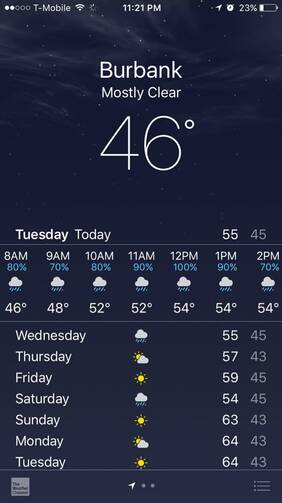If you’re living in Los Angeles and happened to be on Twitter yesterday, it would be hard not to notice that #ElNiño was trending. We had over an inch and a third of rain yesterday—I know that doesn't sound like much, but it is more than the city had any day in 2015 except for Sept. 15, when we got what was left of Mexico’s Hurricane Linda. And the forecasts have been for rains to continue all week—and perhaps intermittently for the next two or three months.
On the surface that sounds like a good thing. After years of drought, if there is one thing California needs, it’s rain.
The paradox is, we are not really made for rain out here. The ground here doesn’t hold much water, which leads to quick flooding and mudslides. Local cities have been stockpiling sand bags and cleaning out storm drains for some time. Even so, in Hollywood yesterday there were streets with large puddles almost immediately after the rains began. Avenues and even three freeways flooded.
It is less one heavy rain that could cause real problems, though, than the possibility of an ongoing series of smaller storms, wearing away at the ever-more water-soaked hills, turning small mudslides into what climatologist Bill Patzert told the L.A. Times could be “mudflows [of] 2 to 3 feet in height.” Current predictions suggest Los Angeles will get two to three inches of rain by Friday, which is as much as downtown Los Angeles usually gets in the entire month.
And the real danger is probably later in the winter. This El Niño is predicted to be one of the three strongest in the last 50 years. Both of the others caused over $500 million in damage here. In February of 1998, Los Angeles got almost 14 inches of rain, which is the Southern California version of "a very bad sign." Seriously, there were people in Pasadena building boats.
Temporary shelters have been opened to support the city’s large homeless population, adding up to 1,131 beds to the 2,000 already in place. But bureaucracy being by nature inhuman, the locations of the temporary shelters can only be discovered by calling 2-1-1 or going to a city website so as to prevent walkups. The idea may be to prevent any one shelter from overcrowding; even so, it’s a bit of a mixed message. Come get out of the rain; but please don't come unannounced.
When it comes to precipitation, Angelenos are easily excited. A gentle misting is classified as a “storm.” At just the threat of rain people refuse to drive. (It’s true. Freeways are always clearer on rainy days. Barring the accidents, of course.) Meteorologists’ news reports become soliloquies equal parts anxiety and adoration.
But at the same time, this is still Los Angeles. People here know hype when they see it. It takes more to be impressed.
weakest el nino ever bruh
— lee (@542e1f462e61411) January 6, 2016Wait and see, bruh. Wait and see.








